Segreliciously Yours
Segrelicious is a state of minds, an experiment in race and culture. One of the curators, Sean Smuda, writes here about how it all is playing out. There's a performance October 20 at Seans studio (see below), and the show runs through October 25.
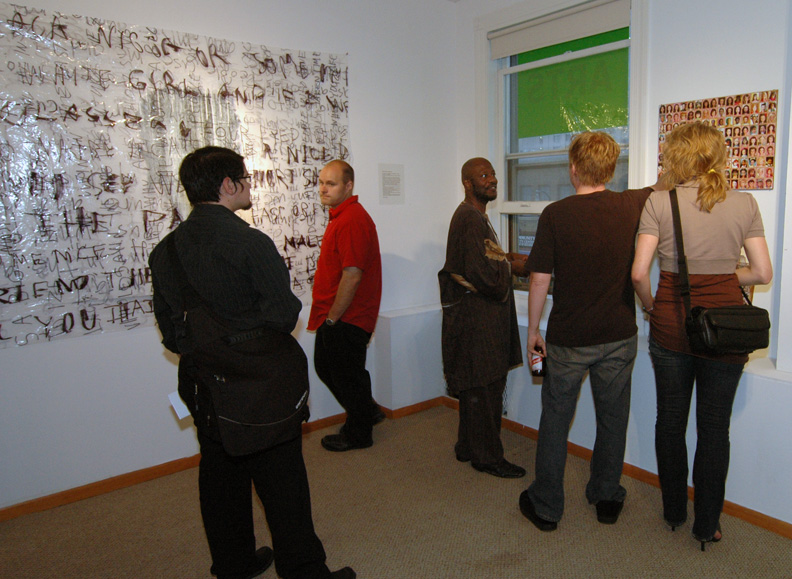
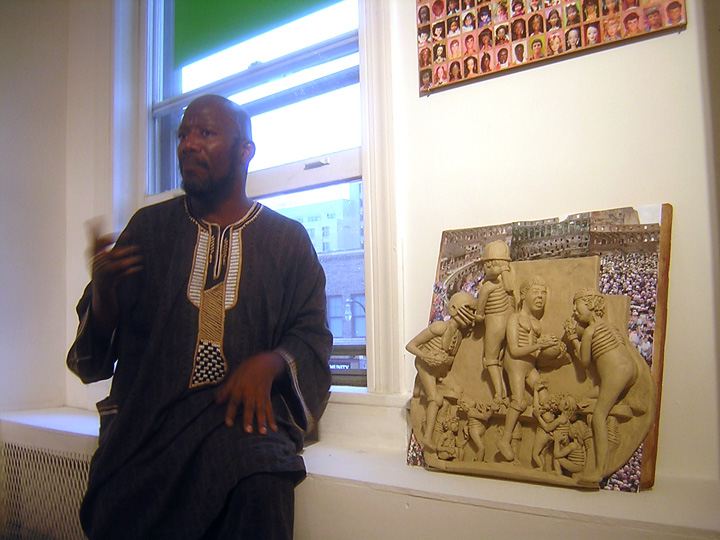
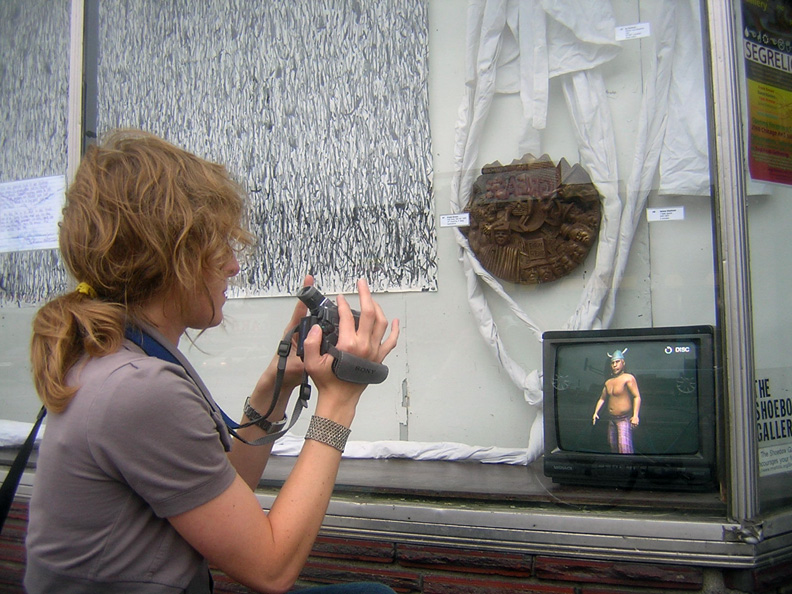
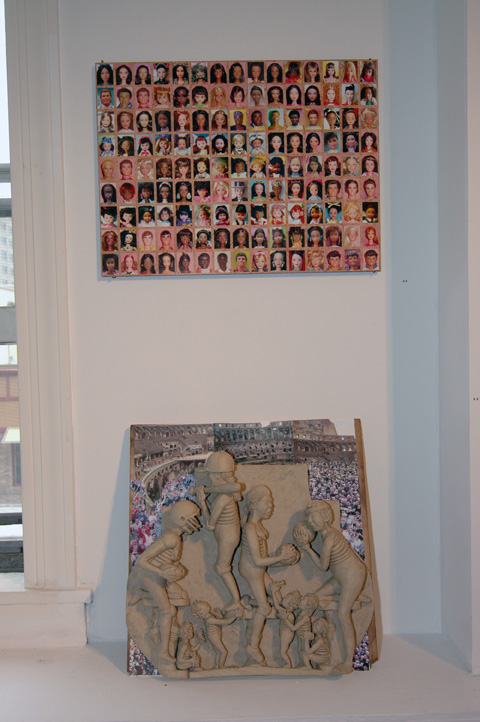
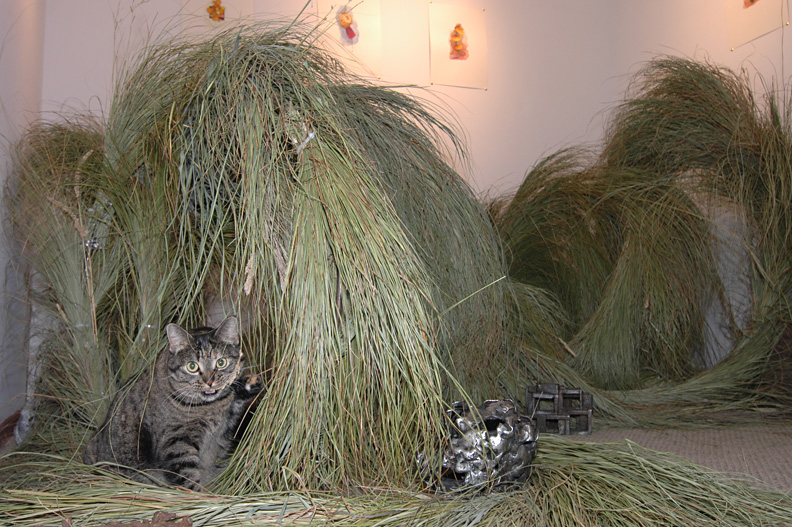
Segrelicious was designed to be a surprise to everyone involved, and it ain’t over yet! Obsidian Arts and the Shoebox Gallery, each about four years old are neighbors in the Roberts Shoes building in south Minneapolis. The former is focused on Afro-American artistic heritage and development and the latter on independent artists. The two got together and with some granting assistance commissioned six artists each to respond to one another’s works. While without specific political agenda the show acknowledges (and in its small way changes) the seemingly self-satisfied segregation (artistic and otherwise) in Minneapolis and St. Paul.
Although cross-pollination is common in music and graffiti, fine arts are frequently the most reclusive areas; this show brings them out to play a bit and the genuine dialogue from their responses are deliciously refreshing in a number of socio-aesthetic ways.
For her initial submission youth artist (St Kate’s bound) Taharra Patterson’s poem with its refrain of “The world is a big place and I’’m just in it” asks the reader to get to know her. The poignancy of the dualities she further invokes is hopeful and fearsome “…it’s the life in us that is the death part of us …the judgment…”
Daniel Kaniess has blown up her words and turned them every which way to let them become a plastic veil over the silhouette of a large painting of an iconic head. His experiment, somewhere between billboard and drawing, evokes the still point of identity beyond its defenses and justifications.
Taharra in turn has responded to his monochromatic painting Voices with the poem Black and White or Nothing at All. She addresses the reader with the line “I can be your heart, your soul I can bring joy to your smile or even sadness to your face”. She once again invites us to get to know her and chastises with “I guess that was your challenge, not believing that the world was colorful and I am something …made up of many things.”
This is exactly what Segrelicious is about: how we can know, not only one another, but the self only through raising and engaging core issues and creating new forms. This is not a stereotypical cross-over alienation rap, but something far less bombastic and more personal, even private. Binary boredom is called out in no uncertain terms.
The dialogue continues with Mica Lee Anders and Juliet Patterson (no relation to Taharra). With a profound meditation on the country Ms. Patterson launches her war influenced poem ECLOGUE as though we had left our bodies and senses for mere words (as in a declaration of war or independence). The consequences play out in a somber landscape where:
“the import and export
of our fathers
half bullies, half tortured
soldiers
consider their barren last vanishing
an epic of unevent—except to find the harbor
rimmed by swallows and canoes—”.
In her response to this unending wasteland vision, Mica Lee Anders has composed a multi-layered light box photogram hearkening to the bleakness of the pre-Civil Rights era. It depicts a hanging in a landscape serenely watched over by the face of a Buddha as big as the sky. Archetype and association reconcile violence with peace.
Juliet in turn has composed the poem Elegy to Mica’s photograph Racial Algebra (an expression of her poly-racial make-up). Elegy honors the quiddity of life, condensing some of ECLOGUE’s themes into a more gardenlike landscape: fecund, but fraught with the constant appearance of self-expulsion.
In a sense these two artists are the most complicated and problematic pair in the show because they address the seemingly immutable forces of life’s appearances and humanity’s face-value use of them. They rise up to one another through the imagistic depth of their taxonomies of the discomfit of living.
Examination of a different sort creates a new path between Frank Brown and James Gladman. In the latter’s I Hate Sports, black-and-white computer-animated sports figures swing into view, take a swing at us and swing back out, over and over again. As we tread the clichéd sensitive artist observation of athletics as offensively belligerent, the meta-humor that race is not a contest sets in. By responding bluntly to the show, Mr. Gladman calls into question what aggressions sports may be sublimating.
For his initial submission Frank Brown presented a bas-relief plaque which has been used as an achievement award in the African-American community. Equal rights, family, scholarship, protest, pyramids and other symbols of heritage are depicted. Made of brown clay, it is as fundamental as earth and skin and the sense of tradition and pride are palpable.
From such divergent origins, I knew that their response pieces were going to be something formidable and they did not disappoint. James Gladman’s response takes on the facelessness of capitalist “tradition” in We Will Crush You. Printed over a photograph of his skin are appropriated images of every nationality of the Barbie doll. They show how one basic matrix need change only slightly to create another. He has reproduced the kind of mass paranoia that sees us as all too similar and ready for mass production-genetic modification: the loss of identity and tradition for the ideal of pure product and the illusion of perfection.
Interestingly, Frank Brown’’s response to I Hate Sports seems to fly in the face of its respondent, but actually takes the dialogue further. The Glory of Sports (another bas-relief) shows money-clutching children worshipping pedestalled athletes. All of their skeletons are partially revealed (a trademark of his work) and behind them, a collaged Roman Coliseum full of white spectators. While Gladman questions the teeth-baring aspects of the game, Frank Brown critiques its economic paradigm. Shown as being a “way up” for black youth, it pessimistically connotes bread and circuses, making us wonder who will care for the young athletes that are eaten by this system.
BR> What has emerged from Segrelicious so far is art beholden only to the differences and similarities of individuals, but that can challenge our notions of division in intricate and compelling ways. It also points to the possibility of art as totemic reminder of what is wrong with a system that divides us from another culture (such as overall racial declensions on either side of I-94) as much from one another. Autonomic behavior and psychological slavery (both concepts as per Deleuze and Guattari’s Capitalism and Schizophrenia, 1972) are nothing new, but the will to transcend and synthesize are always new. Sometimes the synthesis leads to greater creativity (e.g. this was the first time Frank Brown has used collage). Critical thinking, unity and recognition of the other are also results for a healthier praxis.
There are two more visual artists in the show: Io Palmer and Aaron Nicholson, but I can’t really tell you how beautiful and harmonious their work is. With tall grass, archeological cast sculpture, watercolors, and dresses it seems as pastoral an installation as a country wedding. But you’ll have to come down to the Shoebox and Obsidian Arts to see and smell for yourselves.
These are just slightly over half of the artists in the show which goes through October 25. Yet to come are still more surprises. A closing reception and performances on Saturday October 20 will feature Hijack (dance) performing in response to Felix Hampton Brown (theater) and visa versa, as well as musicians Paul Metzger and Davu Seru. Meet the artists, engage your boundaries, extend your narratives! Perhaps the kinds of opportunities this show has provided can lead to a larger, continual and more rigorous critique and enrichment of the cities themselves.
Closing performances and reception on Saturday Oct 20th at 8pm at the Sean Smuda Studio, 2948 Chicago Av S #304, ffi 612.825.3833
Performances are free, small donation suggested.
Segrelicious runs until October 25th at:
Obsidian Arts
2948 Chicago Av S Ste #220
612.822.6808
and
Shoebox Gallery
Storefront window just to the right of 2948 Chicago Av S
612.825.3833